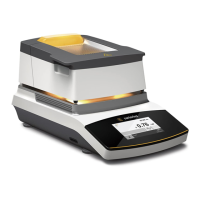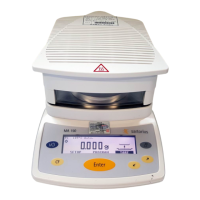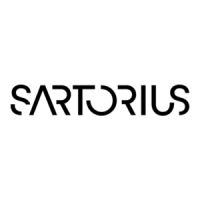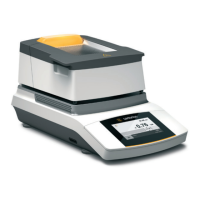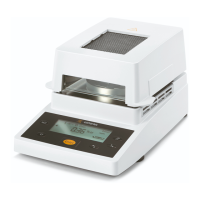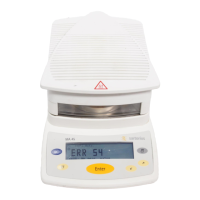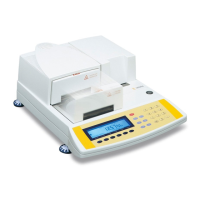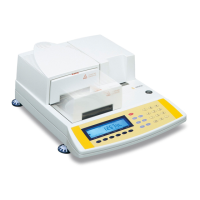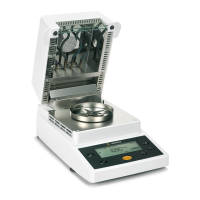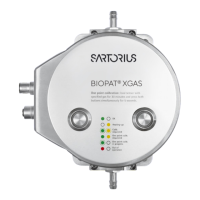Do you have a question about the Sartorius MA100 and is the answer not in the manual?
Explains the symbols used in the operating instructions.
Provides contact information for technical support and applications.
Details hazards for persons and equipment posed by specific sample types.
Covers initial handling, storage conditions, and unpacking procedures.
Lists included components and information on the product warranty.
Provides recommendations for analyzer placement and acclimatization.
Details electrical safety precautions and grounding requirements.
Explains how to connect external devices like printers or PCs.
Information on required warmup time and battery charging.
Instructions for ensuring the analyzer is level for accurate measurements.
How to use quick reference cards and control power.
Procedures for configuring device language and clock settings.
Details the functions of various keys and input methods.
Explains the context-sensitive soft keys and their indications.
Describes the different sections of the analysis and test display.
Explains the meaning of various symbols shown on the display.
Guides users through menu navigation and viewing results.
Details how to configure various analyzer parameters.
Explains the different methods for exporting data.
Information on connecting external devices via the interface port.
Lists and explains error codes and how to resolve them.
Describes how to save analyzer configurations and passwords.
Instructions for changing the analyzer's display language.
Categorizes the various device parameters available for configuration.
Explains how to view, enter, or change specific device parameters.
Provides steps for setting, changing, or deleting user passwords.
Details additional functions like printing parameter settings.
Hierarchical view of all device parameters and their relationships.
Breakdown of parameters for keys, display, clock, and extra functions.
Explains how to customize individual printout formats.
Details the different settings for printout configuration.
Provides steps to access and view device information.
Explains the purpose and function of the weighing system.
Covers fundamental principles of moisture analysis and thermogravimetry.
Notes applicable to specific MA100 models regarding calibration.
Explains how IR rays interact with samples for heating.
Highlights common mistakes in applying samples for analysis.
Guides on adapting analyzer methods to existing measurement systems.
Details the asap mode and setting shutoff parameters.
Covers selecting representative samples and homogenization techniques.
Provides guidelines for the proper use of disposable sample pans.
Instructions for applying samples evenly to the sample pan.
Methods to prevent crust or skin formation on samples during analysis.
Structure and categories of drying parameters.
Details the four available heating programs for analysis.
Settings for initial weight, start, and end of analysis.
Configures decimal places for weight and display units.
Settings for printing intermediate results and identification codes.
Details program types like standard, quick, gentle, and phase drying.
Explains various modes for starting and ending analysis.
Details asap and semi-automatic modes for parameter determination.
Settings for weight resolution and display units.
Covers intermediate results, IDs, search, and factory settings.
Lists functions available within the program memory.
Provides a list of available soft key functions.
Overview of how analysis data is presented on the display.
Explains the use and entry of identification codes for analysis.
Guides on how to temporarily change the display mode settings.
Details how to view and print statistical analysis data.
Lists the available functions within the isoTEST menu.
Guides on how to adjust temperature settings for the heating unit.
Details calibration and adjustment procedures for the weighing system.
Explains how to select different calibration/adjustment modes.
Describes how to perform tests to determine weighing system repeatability.
Steps to initiate hardware tests for system components.
Procedure for testing the SBI communication interface.
Procedure for testing the optional internal printer.
Procedure for testing digital input/output ports.
Steps to perform tests on the heater unit.
Procedures for adjusting the heating unit's parameters.
Details how data is displayed internally on the analyzer.
Explains the information displayed about drying programs.
Guides on interpreting bar graphs and display symbols.
Describes the lines showing moisture analysis results.
Explains weight units and operational symbols.
Details explanatory text lines and soft key indications.
Lists the capabilities of the interface port.
Important warning regarding the use of RS-232 cables.
Details the default factory settings for the interface port.
Explains the structure and formatting of data outputs.
A comprehensive list and explanation of all error codes.
Lists and explains status codes for different application states.
Describes the format for sending data to the analyzer.
Details various formats for control commands.
Ensures synchronized data transfer between devices.
Explains how to configure handshake modes for data transfer.
Describes methods for activating data output.
Details how to monitor and remotely control the analyzer.
Lists functions for remote control via external devices.
Table showing analyzer states and corresponding pin signals.
Specifications for the female interface connector.
Specifications for the male interface connector.
Provides a comprehensive list of pin assignments for the interface.
Lists common error messages and their potential causes.
Provides solutions and recommendations for resolving errors.
Guidelines for routine servicing, repairs, and general cleaning.
Specific instructions for cleaning the heating unit and sensor.
Procedure for replacing the fan air filter.
Step-by-step instructions for replacing fuses.
Details on disassembling or replacing the heating unit.
Criteria indicating when safe operation may be compromised.
Technical specifications for models without EC type-approval.
Information on the Council Directive for weighing instruments.
Details on the EC verification service offered by Sartorius.
Information on the validity of verifications in Europe.
Explains the symbols used in the operating instructions.
Provides contact information for technical support and applications.
Details hazards for persons and equipment posed by specific sample types.
Covers initial handling, storage conditions, and unpacking procedures.
Lists included components and information on the product warranty.
Provides recommendations for analyzer placement and acclimatization.
Details electrical safety precautions and grounding requirements.
Explains how to connect external devices like printers or PCs.
Information on required warmup time and battery charging.
Instructions for ensuring the analyzer is level for accurate measurements.
How to use quick reference cards and control power.
Procedures for configuring device language and clock settings.
Details the functions of various keys and input methods.
Explains the context-sensitive soft keys and their indications.
Describes the different sections of the analysis and test display.
Explains the meaning of various symbols shown on the display.
Guides users through menu navigation and viewing results.
Details how to configure various analyzer parameters.
Explains the different methods for exporting data.
Information on connecting external devices via the interface port.
Lists and explains error codes and how to resolve them.
Describes how to save analyzer configurations and passwords.
Instructions for changing the analyzer's display language.
Categorizes the various device parameters available for configuration.
Explains how to view, enter, or change specific device parameters.
Provides steps for setting, changing, or deleting user passwords.
Details additional functions like printing parameter settings.
Hierarchical view of all device parameters and their relationships.
Breakdown of parameters for keys, display, clock, and extra functions.
Explains how to customize individual printout formats.
Details the different settings for printout configuration.
Provides steps to access and view device information.
Explains the purpose and function of the weighing system.
Covers fundamental principles of moisture analysis and thermogravimetry.
Notes applicable to specific MA100 models regarding calibration.
Explains how IR rays interact with samples for heating.
Highlights common mistakes in applying samples for analysis.
Guides on adapting analyzer methods to existing measurement systems.
Details the asap mode and setting shutoff parameters.
Covers selecting representative samples and homogenization techniques.
Provides guidelines for the proper use of disposable sample pans.
Instructions for applying samples evenly to the sample pan.
Methods to prevent crust or skin formation on samples during analysis.
Structure and categories of drying parameters.
Details the four available heating programs for analysis.
Settings for initial weight, start, and end of analysis.
Configures decimal places for weight and display units.
Settings for printing intermediate results and identification codes.
Details program types like standard, quick, gentle, and phase drying.
Explains various modes for starting and ending analysis.
Details asap and semi-automatic modes for parameter determination.
Settings for weight resolution and display units.
Covers intermediate results, IDs, search, and factory settings.
Lists functions available within the program memory.
Provides a list of available soft key functions.
Overview of how analysis data is presented on the display.
Explains the use and entry of identification codes for analysis.
Guides on how to temporarily change the display mode settings.
Details how to view and print statistical analysis data.
Lists the available functions within the isoTEST menu.
Guides on how to adjust temperature settings for the heating unit.
Details calibration and adjustment procedures for the weighing system.
Explains how to select different calibration/adjustment modes.
Describes how to perform tests to determine weighing system repeatability.
Steps to initiate hardware tests for system components.
Procedure for testing the SBI communication interface.
Procedure for testing the optional internal printer.
Procedure for testing digital input/output ports.
Steps to perform tests on the heater unit.
Procedures for adjusting the heating unit's parameters.
Details how data is displayed internally on the analyzer.
Explains the information displayed about drying programs.
Guides on interpreting bar graphs and display symbols.
Describes the lines showing moisture analysis results.
Explains weight units and operational symbols.
Details explanatory text lines and soft key indications.
Lists the capabilities of the interface port.
Important warning regarding the use of RS-232 cables.
Details the default factory settings for the interface port.
Explains the structure and formatting of data outputs.
A comprehensive list and explanation of all error codes.
Lists and explains status codes for different application states.
Describes the format for sending data to the analyzer.
Details various formats for control commands.
Ensures synchronized data transfer between devices.
Explains how to configure handshake modes for data transfer.
Describes methods for activating data output.
Details how to monitor and remotely control the analyzer.
Lists functions for remote control via external devices.
Table showing analyzer states and corresponding pin signals.
Specifications for the female interface connector.
Specifications for the male interface connector.
Provides a comprehensive list of pin assignments for the interface.
Lists common error messages and their potential causes.
Provides solutions and recommendations for resolving errors.
Guidelines for routine servicing, repairs, and general cleaning.
Specific instructions for cleaning the heating unit and sensor.
Procedure for replacing the fan air filter.
Step-by-step instructions for replacing fuses.
Details on disassembling or replacing the heating unit.
Criteria indicating when safe operation may be compromised.
Technical specifications for models without EC type-approval.
Information on the Council Directive for weighing instruments.
Details on the EC verification service offered by Sartorius.
Information on the validity of verifications in Europe.
| Capacity | 100 g |
|---|---|
| Readability | 0.1 mg |
| Weighing pan size | 90 mm diameter |
| Display | LCD |
| Interface | RS232 |
| Measurement Principle | Electromagnetic force compensation |
| Repeatability (standard deviation) | 0.0001 g (0.1 mg) |
| Weighing Range | 0 to 100 g |
| Power Supply | 50/60 Hz |
